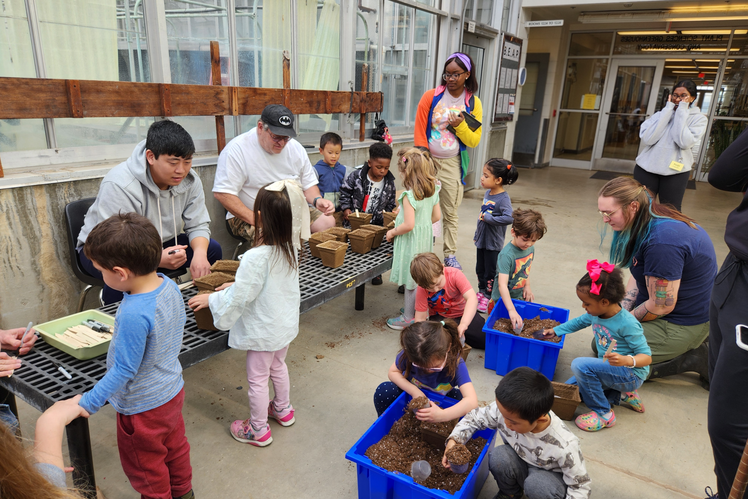Interpreting nature: NRES students practice environmental communication in a new class

Students in the College of Agricultural, Consumer and Environmental Sciences know communication is key. From public speaking requirements to advanced composition classes, ACES students are trained to share their knowledge with the world. Pam Leiter, the recruitment coordinator for the Department of Natural Resources and Environmental Sciences, is part of that effort. In her environmental education and heritage interpretation class, offered for the second time this spring, she’s teaching students how to help all kinds of audiences connect with nature — all while providing professional development. By the end of the course, students are eligible to become Certified Interpretive Guides through the National Association for Interpretation.
Creating future educators
Leiter is an environmental education superstar with three decades of experience under her belt. She’s managed nature centers, served on the boards of local environmental organizations, and has been a Certified Interpretive Guide for 20 years. She defines interpretation as “communicating any topic to any audience in a way that connects to them.” Think of a museum guide leading kids on a class field trip, or a park ranger taking a group of birdwatchers on a hike. Their task is to interpret the artifacts and environment around them — to make sense of them in a way that resonates for their particular audience.
“Students often ask about ways to get certifications by the time they graduate, and alumni often wish they had more communications training,” Leiter said. “With my years of experience, I knew I could easily create a class that would add this back into our curriculum and be a huge benefit to our students.”
Leiter’s class is one of several topics offered for NRES 385, the department’s listing for field experience courses, and she plans to offer the class every spring semester. Upon completion of the environmental education and heritage interpretation option, students are eligible to become Certified Interpretive Guides through the National Association for Interpretation.
Like most NAI interpretive guides, Leiter earned her certification through a week-long professional development workshop. Other universities had experimented with converting that workshop into a full-length class, which Leiter wanted to emulate. “The workshop is usually taken by people who are actively doing interpretation day-to-day in their jobs,” she said. “So my challenge was to help college students who might not have that experience, and help them not only get all the requirements for the certification, but also have them see interpretation in action.”
Interpretation in action
The students are first introduced to interpretation in the classroom. Drawing on her experience as an interpretive guide, Leiter used interpretive principles, and activities the students could use in their careers, to teach the class content. These included theme-based classes, interactives, creative instructional techniques, games, and handling a live turtle and biofacts. “First of all, it’s more fun to do it that way,” Leiter said. “It’s also experiential, which is a key component of interpretation. So I tried to model that as an interpreter.”
During the second half of the class, learning moves outdoors in the form of weekly field trips. Leiter, who is heavily involved in environmental issues around Urbana-Champaign, took advantage of her professional connections to plan these excursions. Students observed a day at the Bluestem Hall Nature School, accompanied Child Development Lab preschoolers on a trip to the campus conservatory, got a look behind the scenes with the educational programming team at the Anita Purves Nature Center, and learned how to make exhibits on a budget at the Illinois Natural History Survey, part of the Prairie Research Institute at U. of I.
The class ends with student presentations, which are required to earn the interpretive guide certification. Last spring, some students were interested in environmental education careers, so they developed programs on mountain goats and beetles. Others picked more unusual topics. “I was pleased to see everybody did something that seemed personally significant to them,” Leiter said. “You can take any topic from veterinary science to classical Indian dance to bird-window strikes and apply interpretive principles — which the students did.”
Given the class’ broad implications, NRES students aren’t the only ones signing up. The College of Education was also excited for the course to come back, Leiter said. “Some of their education majors decide they don't want to be in a traditional classroom. They want to do more nonformal education, so they might be really interested in taking this kind of class as well.”
Despite the class’ broad scope, Leiter still thinks that environmental issues are the perfect conduit for teaching interpretation skills. “The environment affects everyone,” Leiter said. “Some people aren’t outdoorsy, but I think most human beings have some felt connection to nature, whether it's through the food they eat, the birds they see, or the sunsets they enjoy. My hope is that, as interpreters, we can find ways to build bridges between people with various worldviews and different values, to help make the world a better place.”
Interested students can sign up for NRES 385 Environmental Education and Heritage Interpretation, offered yearly in the spring.